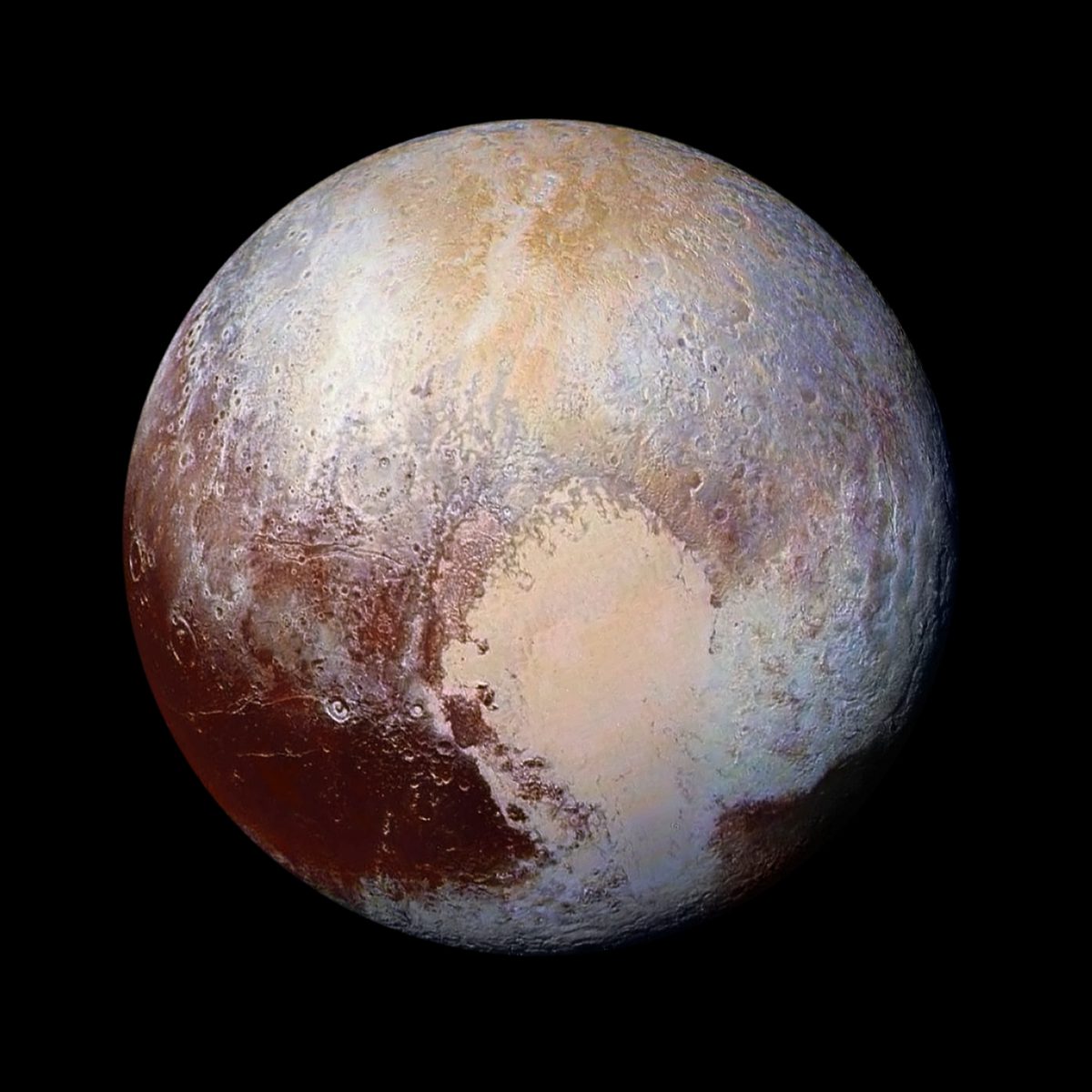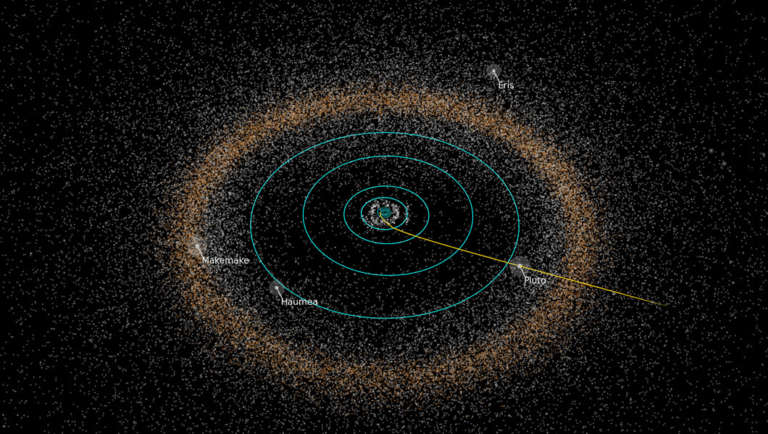Jamie Carter • Oct 11, 2022
How JWST will reveal our Solar System beyond Neptune
NASA’s James Webb Space Telescope may soon demystify the realm of Pluto and many other icy worlds.
Since its launch in December 2021, JWST has sent back dazzling photos of distant exoplanets, intricate nebula nurseries, and galaxies whose light has taken over 13 billion years to reach our eyes. Soon, it will set its sights on the Kuiper belt, a massive disc just beyond Neptune’s orbit that’s home to comets, asteroids, and other icy bodies.
Pluto was classified as a dwarf planet in 2006, but it’s also categorized as both a trans-Neptunian object (TNO) and a Kuiper belt object (KBO). Planetary scientists consider it a TNO because Pluto’s orbit sometimes crosses Neptune’s, and a KBO because it’s one of the biggest known objects in the Kuiper belt.
The worlds and objects beyond Neptune are largely unexplored territory — Pluto included. But work has begun on using JWST to uncover them.

What is the Kuiper belt?
The Kuiper belt is a disc in the outer Solar System that stretches from about 30 astronomical units (AU) where Neptune orbits, to about 50 AU.
The Kuiper belt was proposed by Gerard Kuiper in 1951, though it’s sometimes also called the Edgeworth-Kuiper belt to include Kenneth Essex Edgeworth, who also described it in 1943. The uncertainty about what to call this disc led to the creation of the term TNO to describe objects in the region.
“Kuiper proposed that there would be a population of objects left over from the formation of the giant planets that would sit at the orbit of Neptune and beyond,” said Jonathan Lunine, a planetary scientist at Cornell University and member of JWST’s science team whose focus is on using the telescope to study extrasolar planets and Kuiper belt objects. Alongside Pluto, some of the objects that call the Kuiper belt home include Halley’s Comet and the dwarf planets Eris, Haumea, and Makemake.

How JWST will study the Kuiper belt
As JWST continues its mission of exploring the Universe with greater depth and sensitivity than any telescope, it will be able to see Kuiper belt objects in an entirely new light.
“Its raw infrared sensitivity will allow us to get good signals [from Kuiper belt objects] because these are obviously very cold, very distant, and relatively small bodies,” said Lunine.
For planetary scientists, JWST’s greatest strength is its incredible spatial resolution combined with its ability to capture images using infrared spectroscopy. JWST’s cameras will be able to use sunlight reflected by objects in the Kuiper belt to study the absorption and emission lines that show which atoms, molecules, ices, and minerals are giving off light that vibrate in its atmosphere.
Away from Earth’s atmosphere, which blocks infrared light, the JWST Near InfraRed Spectrograph (NIRSpec) integral field unit will reveal these objects’ light from the near-infrared to the beginning of the far infrared.
“JWST covers a broad wavelength range, so we will see where these various molecules that might be on the surface have their primary vibrations,” said Lunine. This way, scientists hope to see materials that they could have never detected using Earth-based telescopes.
“If you make this wonderful beef stew of some kind and mix all the ingredients together it obscures what you started with,” Lunine said. “We want to sort the crumbs on the table from the original ingredients so we can understand where all of this came from and the original distribution of these molecules.”
That “beef stew” is material left over from the formation of the Solar System, Lunine said. “Some of these objects have probably been in the belt since the formation of the giant planets.”
As Uranus and Neptune's orbits became larger and moved outward during formation, they pushed the Kuiper belt out, scattering dwarf planets and smaller bodies both into its doughnut-like field and away from it, throwing some objects closer to the Sun.
Triton, an icy moon of Neptune, is considered a captured object from the Kuiper belt because its orbit is highly inclined with respect to Neptune, and it rotates backward. About 1,700 kilometers (about 1,056 miles) miles in diameter, Triton is geologically active and thought to be an ocean world. Pluto is famous for its former planet status, but Eris is less well known. Upon its discovery in 2005 by astronomers Mike Brown, Chad Trujillo, and David Rabinowitz at the California Institute of Technology, scientists initially thought it was larger than Pluto, which was a factor in Pluto’s controversial demotion from its status as the ninth planet of our Solar System to dwarf planet. After all, if Pluto is a planet, then based on its size alone, so is Eris. Aptly named after the Greek goddess of conflict, Eris has since been revealed to be about the same size and density as Pluto.
There are many other bodies in the Kuiper belt — observers have cataloged thousands, but astronomers estimate that there are hundreds of thousands more yet to be discovered.
“As you go down in size you get more and more objects, but there are thousands of KBOs ranging from tens of kilometers upward,” said Lunine. Objects are expelled from the Kuiper belt all the time through close interactions and collisions, as well as interactions with the planets. In fact, the Kuiper belt is eroding, as more and more objects scatter away.

Uncovering the Kuiper belt with JWST
JWST will soon begin studying these distant worlds as part of two Kuiper belt science proposals.
Lunine is the principal investigator on proposal 1273 to examine dwarf planet Haumea, a KBO called Quaoar, the Amycus Trojan asteroid, and three centaurs (objects between the orbits of Jupiter and Neptune and possible interlopers from the Kuiper belt) called 2008 FC76, Pholus and 2002 KY14. Meanwhile, a complementary proposal 1272 will study Neptune’s moon Triton, dwarf planet Sedna, and two centaurs called 2013XZ8 and Chariklo. These are just the first early reconnaissance studies using JWST, with other dwarf planets Eris, Haumea, and Makemake — as well as Pluto — being the targets of future observations.
“What we’re trying to do is to share these observations and combine them so we can study a number of these objects ranging in size from Pluto on down,” said Lunine. “We're going to discover a tremendous amount about the composition of their surfaces and the distribution of ices.”
Discoveries within the Kuiper belt aren’t all resting on JWST’s shoulders, however. A new ground-based telescope in Chile called the Vera C. Rubin Observatory (formerly the Large Synoptic Survey Telescope, or LSST) is expected to revolutionize the study of KBOs in a different way to JWST. It’s a 6.5-meter-class optical telescope with a 3.2-gigapixel CCD imaging camera, the largest ever built.
“Its optical system gives a very wide field designed to discover transient astrophysical and astronomical events and objects,” said Lunine. “One of those is KBOs that we don't yet know about — it’s going to be a big new discovery tool.”
Editor's Note: this article previously listed Ceres as an object in the Kuiper Belt. We regret the error.
Support our core enterprises
Your support powers our mission to explore worlds, find life, and defend Earth. You make all the difference when you make a gift. Give today!
Donate

 Explore Worlds
Explore Worlds Find Life
Find Life Defend Earth
Defend Earth

